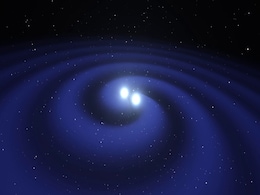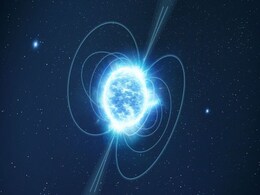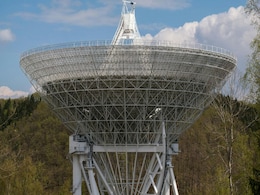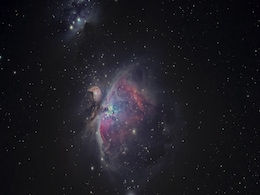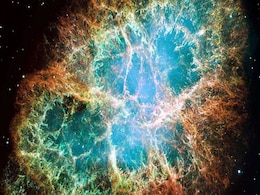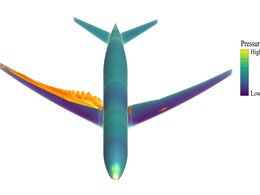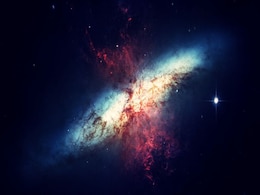Neutron Star
- All
- News
-

Magnetic Fields Could Significantly Influence Oscillations in Merging Neutron Stars, Study Finds
- Saturday April 26, 2025
- Written by Gadgets 360 Staff
Magnetic fields may play a bigger role in neutron star mergers than previously thought. A new study using advanced simulations shows that these fields can shift or suppress oscillation frequencies, altering gravitational wave signatures. This discovery could change how astronomers decode post-merger signals and refine models of neutron star interio...
-
 www.gadgets360.com
www.gadgets360.com
-

NASA Hubble Space Telescope Helps Confirm the First Solitary Black Hole
- Friday April 18, 2025
- Written by Gadgets 360 Staff
In the Sagittarius constellation, a lone and first-ever solitary black hole has been discovered by a team of scientists. Although the discovery began in the year 2011, the observations have confirmed it recently. The size of this black hole is as massive as seven times of the sun. Despite the conflicts and differences of observations by another tea...
-
 www.gadgets360.com
www.gadgets360.com
-

NASA’s Hubble Space Telescope Tracks a Neutron Star With Mysterious Origin
- Wednesday April 16, 2025
- Written by Gadgets 360 Staff
NASA’s Hubble Space Telescope spotted a rogue magnetar, dubbed SGR 0501+4516, traversing our galaxy for a significantly long time. As per claims by scientists, it was first discovered in the year 2008 by NASA's Swift Observatory as intense flashes of gamma rays in the outer area of the Milky Way
-
 www.gadgets360.com
www.gadgets360.com
-

Supernova Remnants Found in Oceanic Samples, Scientists Look to Moon
- Wednesday March 26, 2025
- Written by Gadgets 360 Staff
Scientists have identified supernova debris in deep-sea sediments, including a rare plutonium isotope linked to a kilonova. Researchers believe a neutron star collision occurred nearly 10 million years ago, scattering radioactive material across space. To validate this theory, they plan to analyze lunar soil, which remains undisturbed by Earth's ge...
-
 www.gadgets360.com
www.gadgets360.com
-

Unusual X-ray Flash in Large Magellanic Cloud Puzzles Astronomers
- Tuesday February 25, 2025
- Written by Gadgets 360 Staff
A brief yet intense X-ray flash, XRT 200515, was detected in NASA's Chandra telescope data from 2000. The signal, originating from the Large Magellanic Cloud, has left scientists debating its cause. Possible explanations include a neutron star pulling in gas from a companion star or a powerful flare from a distant magnetar. Researchers also specula...
-
 www.gadgets360.com
www.gadgets360.com
-

FAST Telescope Reveals Emission Properties of Three Long-Period Pulsars in New Study
- Monday February 17, 2025
- Written by Gadgets 360 Staff
The FAST telescope has observed emission behaviours in three long-period pulsars, revealing null phases, asymmetric pulses, and microstructures. The study highlights variations in pulsar emissions and their periodicity, contributing to a deeper understanding of neutron star radio emissions. Researchers noted different nulling fractions and microstr...
-
 www.gadgets360.com
www.gadgets360.com
-

Scientists Investigate Hypernuclei To Understand Subatomic Forces and Neutron Stars
- Monday January 6, 2025
- Written by Gadgets 360 Staff
A groundbreaking study on hypernuclei, led by Ulf-G. Meißner from the Institute for Advanced Simulation, uses nuclear lattice effective field theory to explore the interactions of Λ-hyperons within atomic nuclei. The research, published in The European Physical Journal A, provides key insights into the forces that shape hypernuclei and their pote...
-
 www.gadgets360.com
www.gadgets360.com
-

Scientists Find the Origin of a Mysterious Fast Radio Burst With a Unique Technique
- Friday January 3, 2025
- Written by Gadgets 360 Staff
Researchers have pinpointed the origin of fast radio burst FRB 20221022A to within 10,000 kilometres of a neutron star. Using scintillation analysis, a team from MIT determined that the burst emerged from the magnetosphere, a highly magnetic and chaotic environment surrounding the star. This discovery marks the first conclusive evidence of FRBs ori...
-
 www.gadgets360.com
www.gadgets360.com
-

Asteroids Impacting Neutron Stars May Be the Cause of Fast Radio Bursts
- Tuesday December 10, 2024
- Written by Gadgets 360 Staff
Research suggests asteroid impacts on neutron stars may be the cause of mysterious fast radio bursts (FRBs). These collisions release enormous energy and match observed FRB frequency. Scientists believe interstellar objects colliding with neutron stars could account for their rate and occurrence, while repeating FRBs may stem from asteroid belts. O...
-
 www.gadgets360.com
www.gadgets360.com
-

Arecibo Observatory Data Helps SETI Uncover Secrets of Pulsar Signals and Cosmic Distortions
- Tuesday December 10, 2024
- Written by Gadgets 360 Staff
Data from the now-collapsed Arecibo Observatory continues to drive major discoveries in space science. Sofia Sheikh and her team from the SETI Institute utilised archived data to investigate the signals of pulsars—dense neutron stars emitting radiation like cosmic lighthouses. Their study focused on how these signals are distorted by interstellar...
-
 www.gadgets360.com
www.gadgets360.com
-

Fastest-Moving Stars in the Galaxy May be Piloted by Aliens, New Study Suggests
- Friday November 22, 2024
- Written by Gadgets 360 Staff
A recent study proposes that advanced alien civilisations might utilise binary star systems, especially those involving neutron stars, as massive interstellar spacecraft. By ejecting material in specific directions, the stars could generate thrust, moving the system across the galaxy. Known hypervelocity stars with unusual accelerations are suggest...
-
 www.gadgets360.com
www.gadgets360.com
-

New Research Explains Zebra Pattern in Radio Waves from Crab Nebula
- Tuesday November 19, 2024
- Written by Gadgets 360 Staff
A new model by Mikhail Medvedev from the University of Kansas offers an explanation for the zebra-like pattern in high-frequency radio waves emitted by the Crab Pulsar. The pattern, first discovered in 2007, is likely caused by diffraction and interference of waves in the pulsar's plasma-rich environment. Medvedev’s model could also provide a met...
-
 www.gadgets360.com
www.gadgets360.com
-

NASA Utilises Supercomputing to Drive Space Exploration and Earth Research
- Monday November 18, 2024
- Written by Gadgets 360 Staff
NASA continues to push the boundaries of science by using supercomputing to advance space exploration and climate research. From refining the Artemis II launch pad to leveraging AI for weather forecasting, NASA’s technology is revolutionising space missions and Earth science. Supercomputing helps simulate complex cosmic phenomena, including solar...
-
 www.gadgets360.com
www.gadgets360.com
-

Could a Supernova Threaten Earth’s Survival? Here's What You Need to Know
- Friday November 15, 2024
- Written by Gadgets 360 Staff
Supernova explosions have the potential to harm Earth’s atmosphere, particularly the ozone layer. However, no stars close enough to cause damage are currently identified. The risks are low, but gamma-ray bursts, caused by neutron star mergers, may pose an even greater threat in the future.
-
 www.gadgets360.com
www.gadgets360.com
-

Neutron Star in 4U 1820-30 Spins at Record-Breaking 716 Rotations Per Second
- Wednesday November 6, 2024
- Written by Gadgets 360 Staff
Astronomers have detected a neutron star in the binary system 4U 1820-30 spinning at 716 times per second, breaking records for speed. Located 26,000 light-years from Earth, the star's surface releases explosive thermonuclear bursts that make it shine up to 100,000 times brighter than the Sun. This discovery offers new insights into the extreme pro...
-
 www.gadgets360.com
www.gadgets360.com
-

Magnetic Fields Could Significantly Influence Oscillations in Merging Neutron Stars, Study Finds
- Saturday April 26, 2025
- Written by Gadgets 360 Staff
Magnetic fields may play a bigger role in neutron star mergers than previously thought. A new study using advanced simulations shows that these fields can shift or suppress oscillation frequencies, altering gravitational wave signatures. This discovery could change how astronomers decode post-merger signals and refine models of neutron star interio...
-
 www.gadgets360.com
www.gadgets360.com
-

NASA Hubble Space Telescope Helps Confirm the First Solitary Black Hole
- Friday April 18, 2025
- Written by Gadgets 360 Staff
In the Sagittarius constellation, a lone and first-ever solitary black hole has been discovered by a team of scientists. Although the discovery began in the year 2011, the observations have confirmed it recently. The size of this black hole is as massive as seven times of the sun. Despite the conflicts and differences of observations by another tea...
-
 www.gadgets360.com
www.gadgets360.com
-

NASA’s Hubble Space Telescope Tracks a Neutron Star With Mysterious Origin
- Wednesday April 16, 2025
- Written by Gadgets 360 Staff
NASA’s Hubble Space Telescope spotted a rogue magnetar, dubbed SGR 0501+4516, traversing our galaxy for a significantly long time. As per claims by scientists, it was first discovered in the year 2008 by NASA's Swift Observatory as intense flashes of gamma rays in the outer area of the Milky Way
-
 www.gadgets360.com
www.gadgets360.com
-

Supernova Remnants Found in Oceanic Samples, Scientists Look to Moon
- Wednesday March 26, 2025
- Written by Gadgets 360 Staff
Scientists have identified supernova debris in deep-sea sediments, including a rare plutonium isotope linked to a kilonova. Researchers believe a neutron star collision occurred nearly 10 million years ago, scattering radioactive material across space. To validate this theory, they plan to analyze lunar soil, which remains undisturbed by Earth's ge...
-
 www.gadgets360.com
www.gadgets360.com
-

Unusual X-ray Flash in Large Magellanic Cloud Puzzles Astronomers
- Tuesday February 25, 2025
- Written by Gadgets 360 Staff
A brief yet intense X-ray flash, XRT 200515, was detected in NASA's Chandra telescope data from 2000. The signal, originating from the Large Magellanic Cloud, has left scientists debating its cause. Possible explanations include a neutron star pulling in gas from a companion star or a powerful flare from a distant magnetar. Researchers also specula...
-
 www.gadgets360.com
www.gadgets360.com
-

FAST Telescope Reveals Emission Properties of Three Long-Period Pulsars in New Study
- Monday February 17, 2025
- Written by Gadgets 360 Staff
The FAST telescope has observed emission behaviours in three long-period pulsars, revealing null phases, asymmetric pulses, and microstructures. The study highlights variations in pulsar emissions and their periodicity, contributing to a deeper understanding of neutron star radio emissions. Researchers noted different nulling fractions and microstr...
-
 www.gadgets360.com
www.gadgets360.com
-

Scientists Investigate Hypernuclei To Understand Subatomic Forces and Neutron Stars
- Monday January 6, 2025
- Written by Gadgets 360 Staff
A groundbreaking study on hypernuclei, led by Ulf-G. Meißner from the Institute for Advanced Simulation, uses nuclear lattice effective field theory to explore the interactions of Λ-hyperons within atomic nuclei. The research, published in The European Physical Journal A, provides key insights into the forces that shape hypernuclei and their pote...
-
 www.gadgets360.com
www.gadgets360.com
-

Scientists Find the Origin of a Mysterious Fast Radio Burst With a Unique Technique
- Friday January 3, 2025
- Written by Gadgets 360 Staff
Researchers have pinpointed the origin of fast radio burst FRB 20221022A to within 10,000 kilometres of a neutron star. Using scintillation analysis, a team from MIT determined that the burst emerged from the magnetosphere, a highly magnetic and chaotic environment surrounding the star. This discovery marks the first conclusive evidence of FRBs ori...
-
 www.gadgets360.com
www.gadgets360.com
-

Asteroids Impacting Neutron Stars May Be the Cause of Fast Radio Bursts
- Tuesday December 10, 2024
- Written by Gadgets 360 Staff
Research suggests asteroid impacts on neutron stars may be the cause of mysterious fast radio bursts (FRBs). These collisions release enormous energy and match observed FRB frequency. Scientists believe interstellar objects colliding with neutron stars could account for their rate and occurrence, while repeating FRBs may stem from asteroid belts. O...
-
 www.gadgets360.com
www.gadgets360.com
-

Arecibo Observatory Data Helps SETI Uncover Secrets of Pulsar Signals and Cosmic Distortions
- Tuesday December 10, 2024
- Written by Gadgets 360 Staff
Data from the now-collapsed Arecibo Observatory continues to drive major discoveries in space science. Sofia Sheikh and her team from the SETI Institute utilised archived data to investigate the signals of pulsars—dense neutron stars emitting radiation like cosmic lighthouses. Their study focused on how these signals are distorted by interstellar...
-
 www.gadgets360.com
www.gadgets360.com
-

Fastest-Moving Stars in the Galaxy May be Piloted by Aliens, New Study Suggests
- Friday November 22, 2024
- Written by Gadgets 360 Staff
A recent study proposes that advanced alien civilisations might utilise binary star systems, especially those involving neutron stars, as massive interstellar spacecraft. By ejecting material in specific directions, the stars could generate thrust, moving the system across the galaxy. Known hypervelocity stars with unusual accelerations are suggest...
-
 www.gadgets360.com
www.gadgets360.com
-

New Research Explains Zebra Pattern in Radio Waves from Crab Nebula
- Tuesday November 19, 2024
- Written by Gadgets 360 Staff
A new model by Mikhail Medvedev from the University of Kansas offers an explanation for the zebra-like pattern in high-frequency radio waves emitted by the Crab Pulsar. The pattern, first discovered in 2007, is likely caused by diffraction and interference of waves in the pulsar's plasma-rich environment. Medvedev’s model could also provide a met...
-
 www.gadgets360.com
www.gadgets360.com
-

NASA Utilises Supercomputing to Drive Space Exploration and Earth Research
- Monday November 18, 2024
- Written by Gadgets 360 Staff
NASA continues to push the boundaries of science by using supercomputing to advance space exploration and climate research. From refining the Artemis II launch pad to leveraging AI for weather forecasting, NASA’s technology is revolutionising space missions and Earth science. Supercomputing helps simulate complex cosmic phenomena, including solar...
-
 www.gadgets360.com
www.gadgets360.com
-

Could a Supernova Threaten Earth’s Survival? Here's What You Need to Know
- Friday November 15, 2024
- Written by Gadgets 360 Staff
Supernova explosions have the potential to harm Earth’s atmosphere, particularly the ozone layer. However, no stars close enough to cause damage are currently identified. The risks are low, but gamma-ray bursts, caused by neutron star mergers, may pose an even greater threat in the future.
-
 www.gadgets360.com
www.gadgets360.com
-

Neutron Star in 4U 1820-30 Spins at Record-Breaking 716 Rotations Per Second
- Wednesday November 6, 2024
- Written by Gadgets 360 Staff
Astronomers have detected a neutron star in the binary system 4U 1820-30 spinning at 716 times per second, breaking records for speed. Located 26,000 light-years from Earth, the star's surface releases explosive thermonuclear bursts that make it shine up to 100,000 times brighter than the Sun. This discovery offers new insights into the extreme pro...
-
 www.gadgets360.com
www.gadgets360.com

